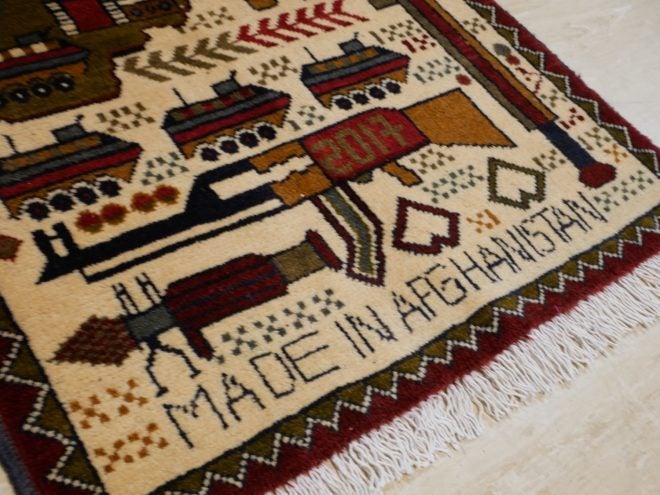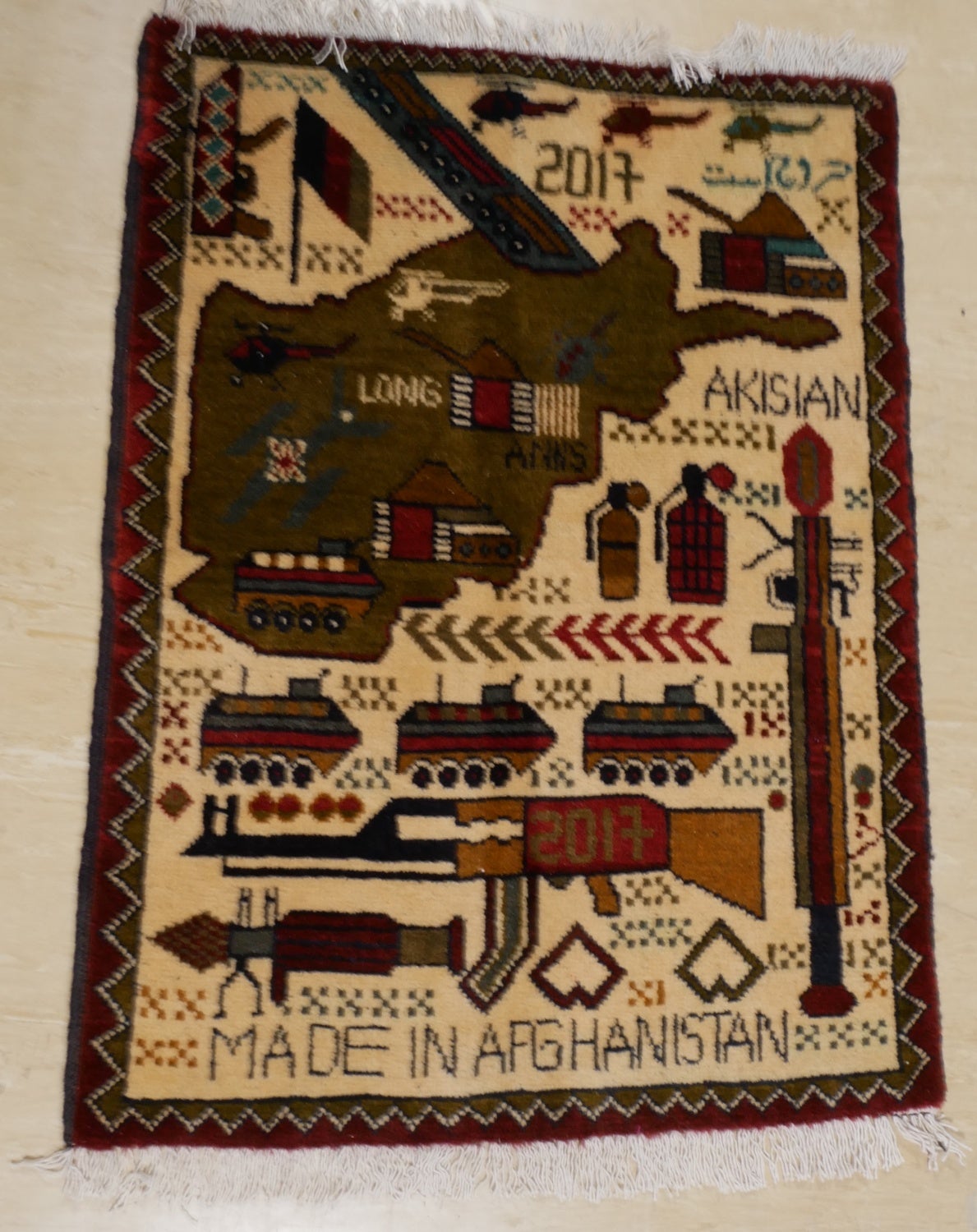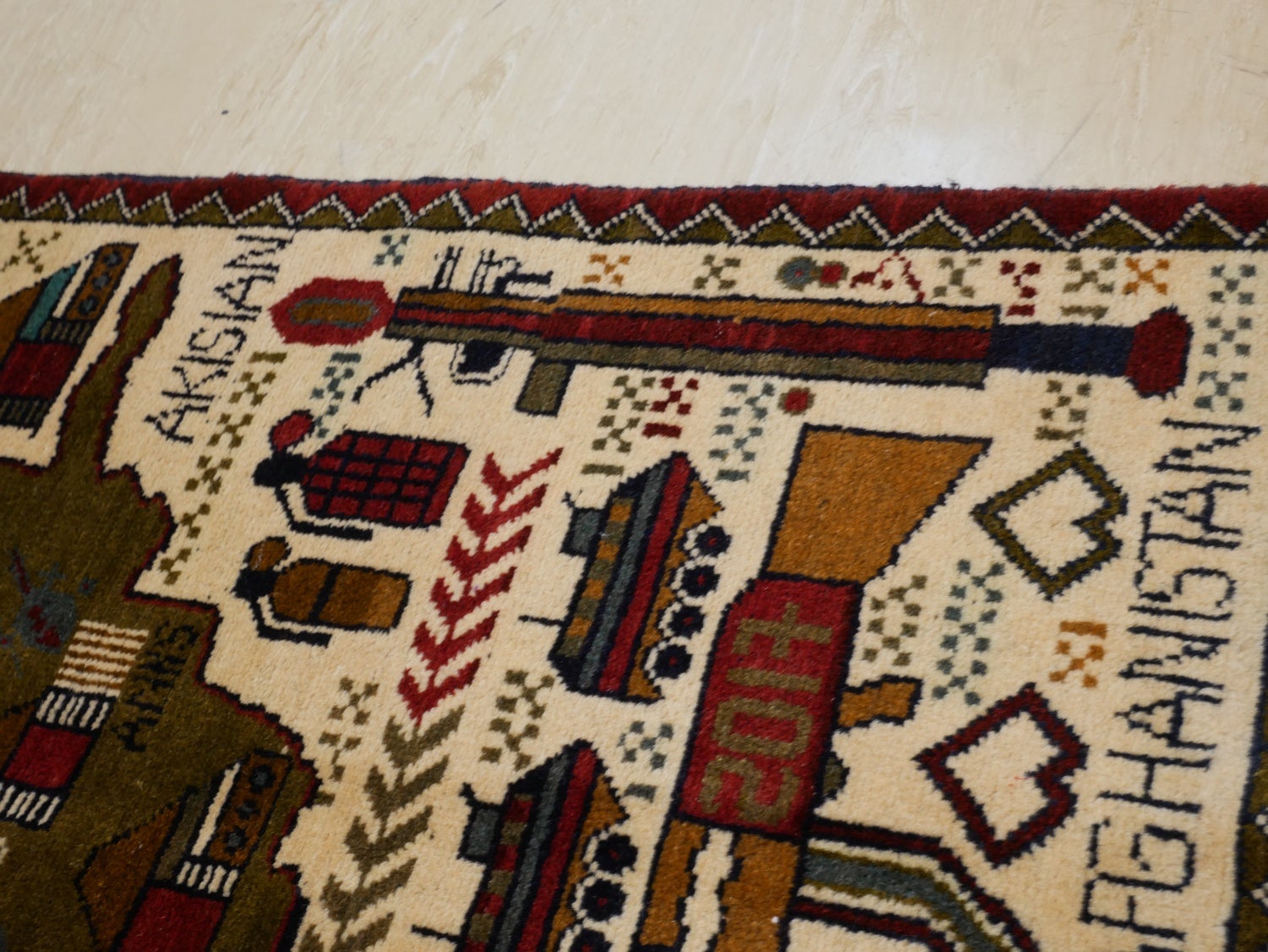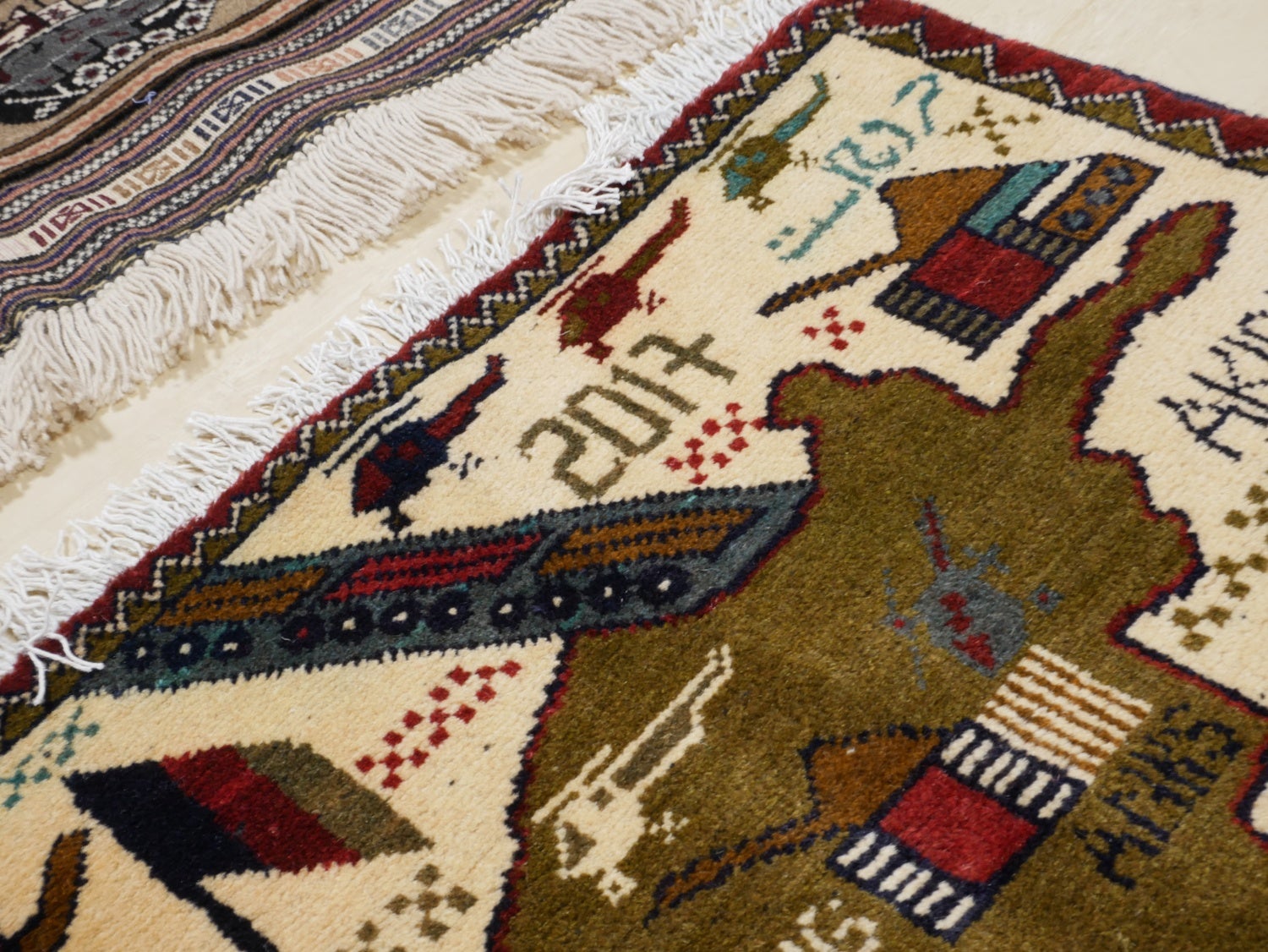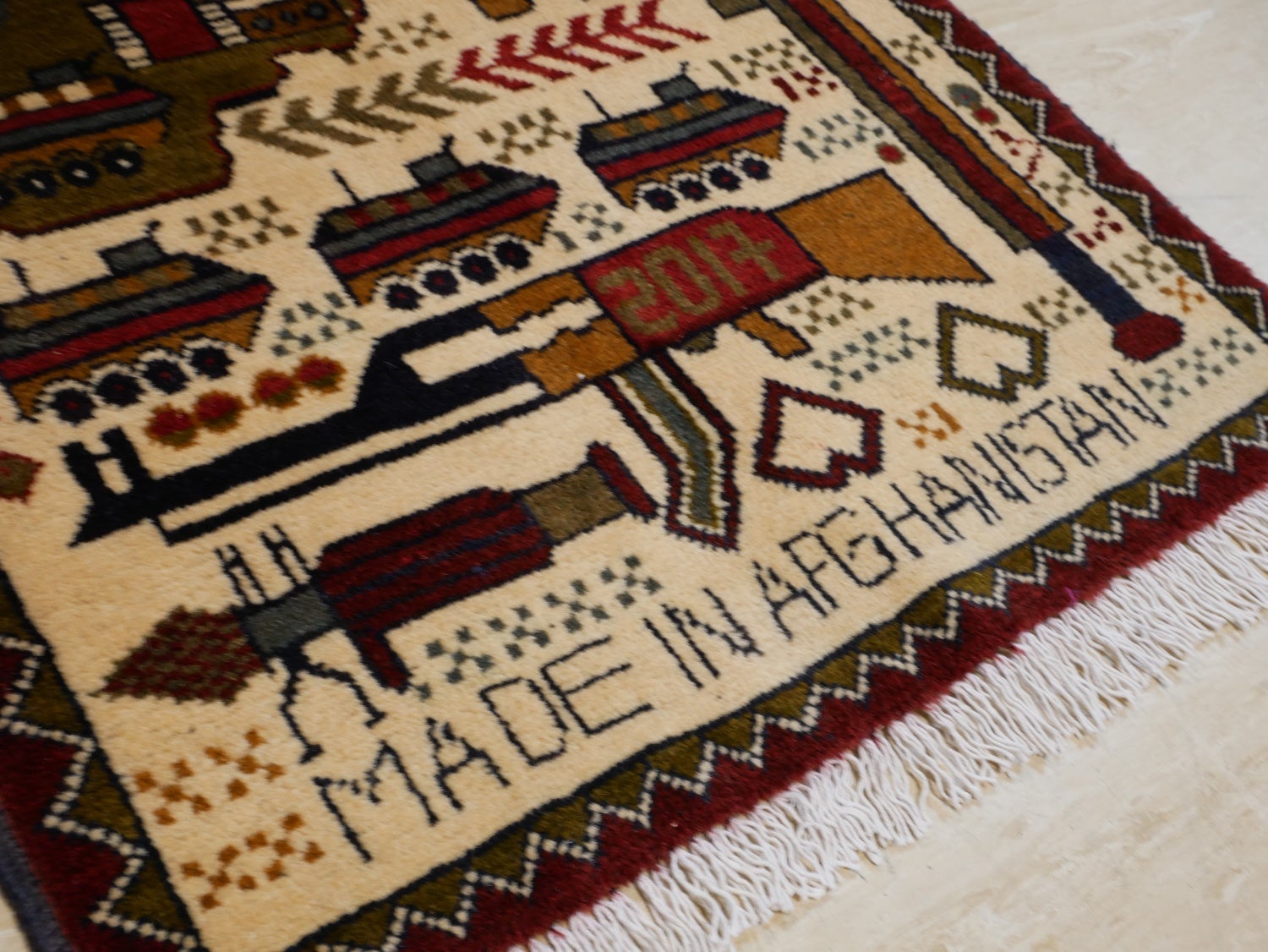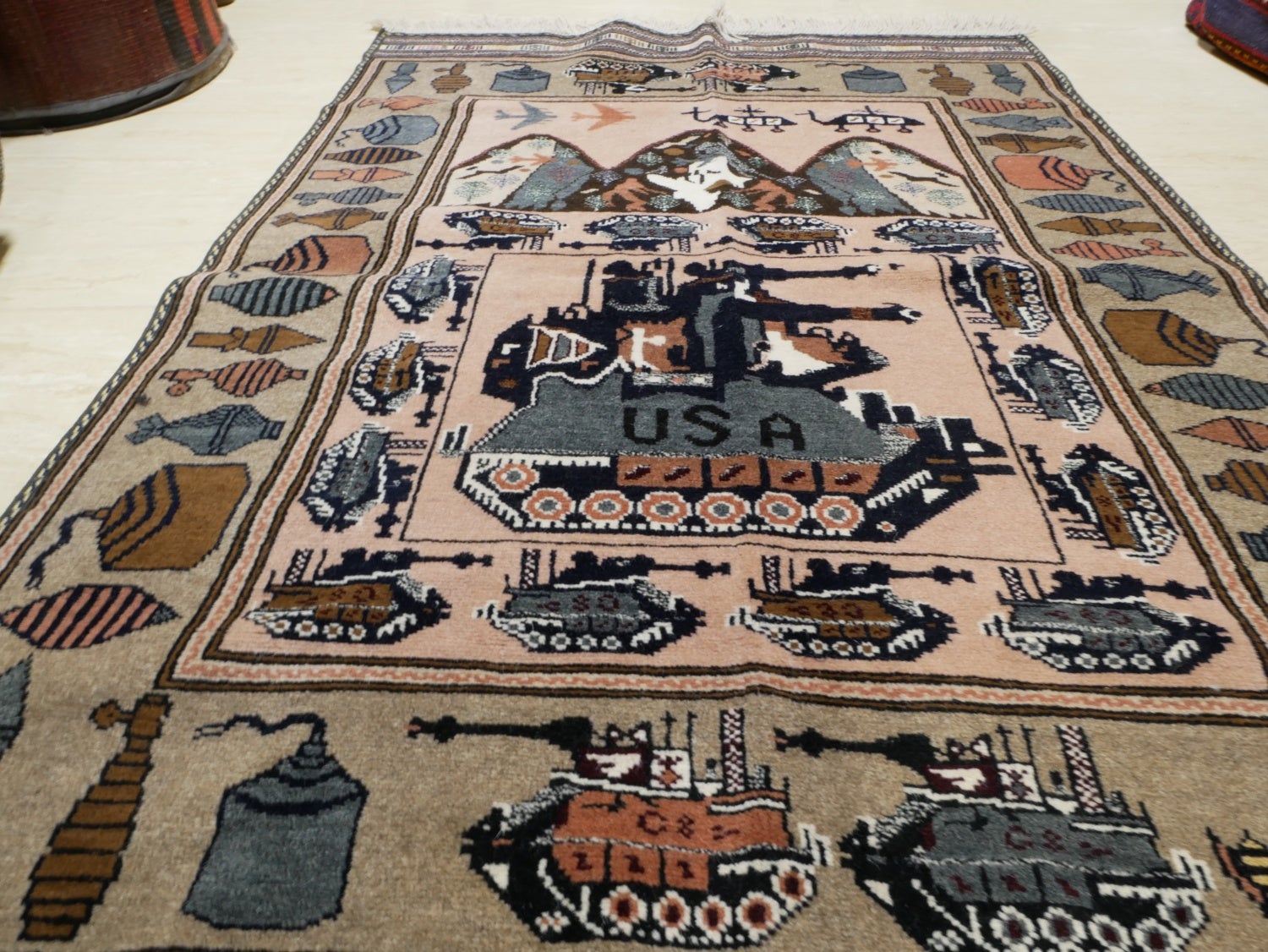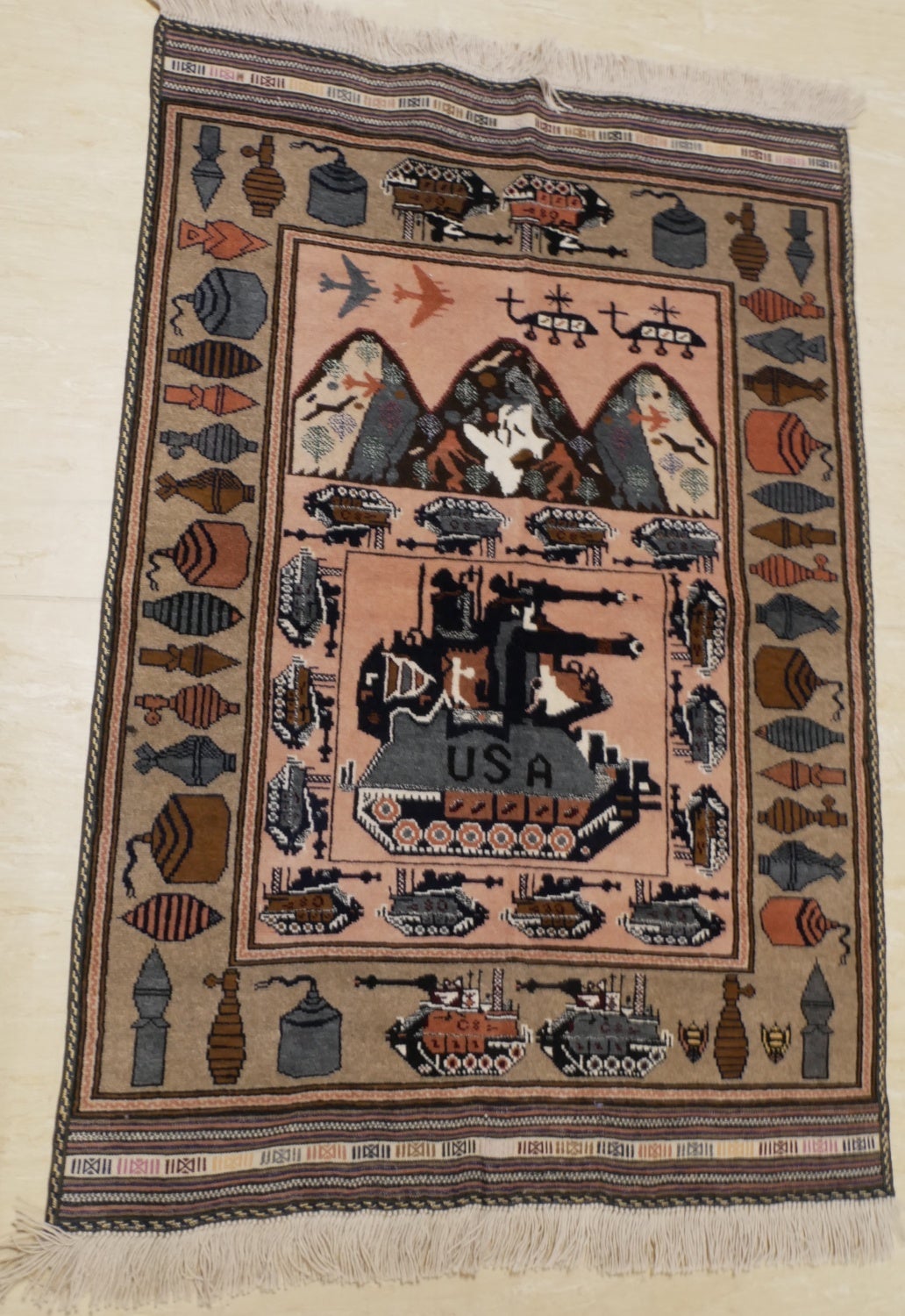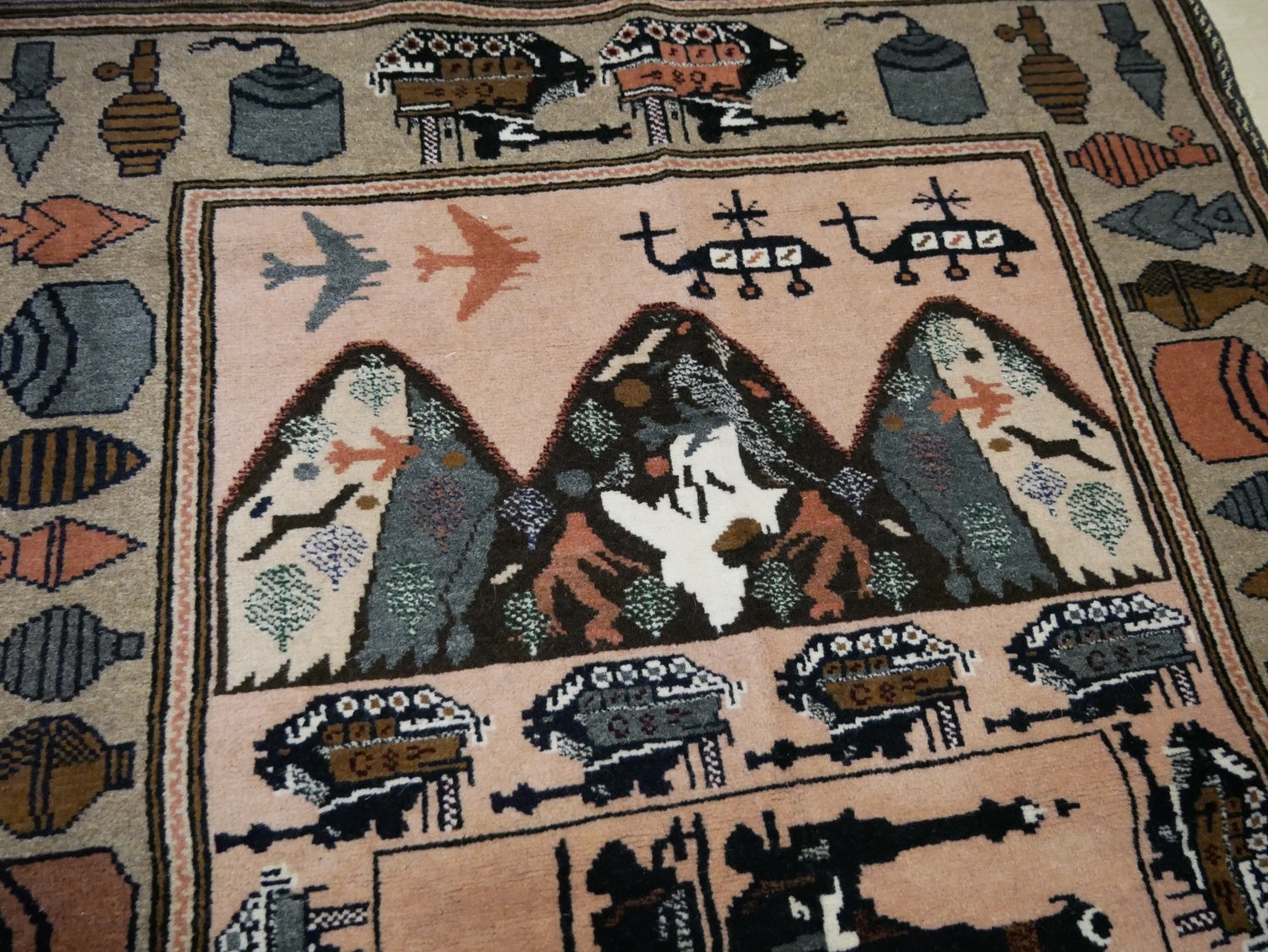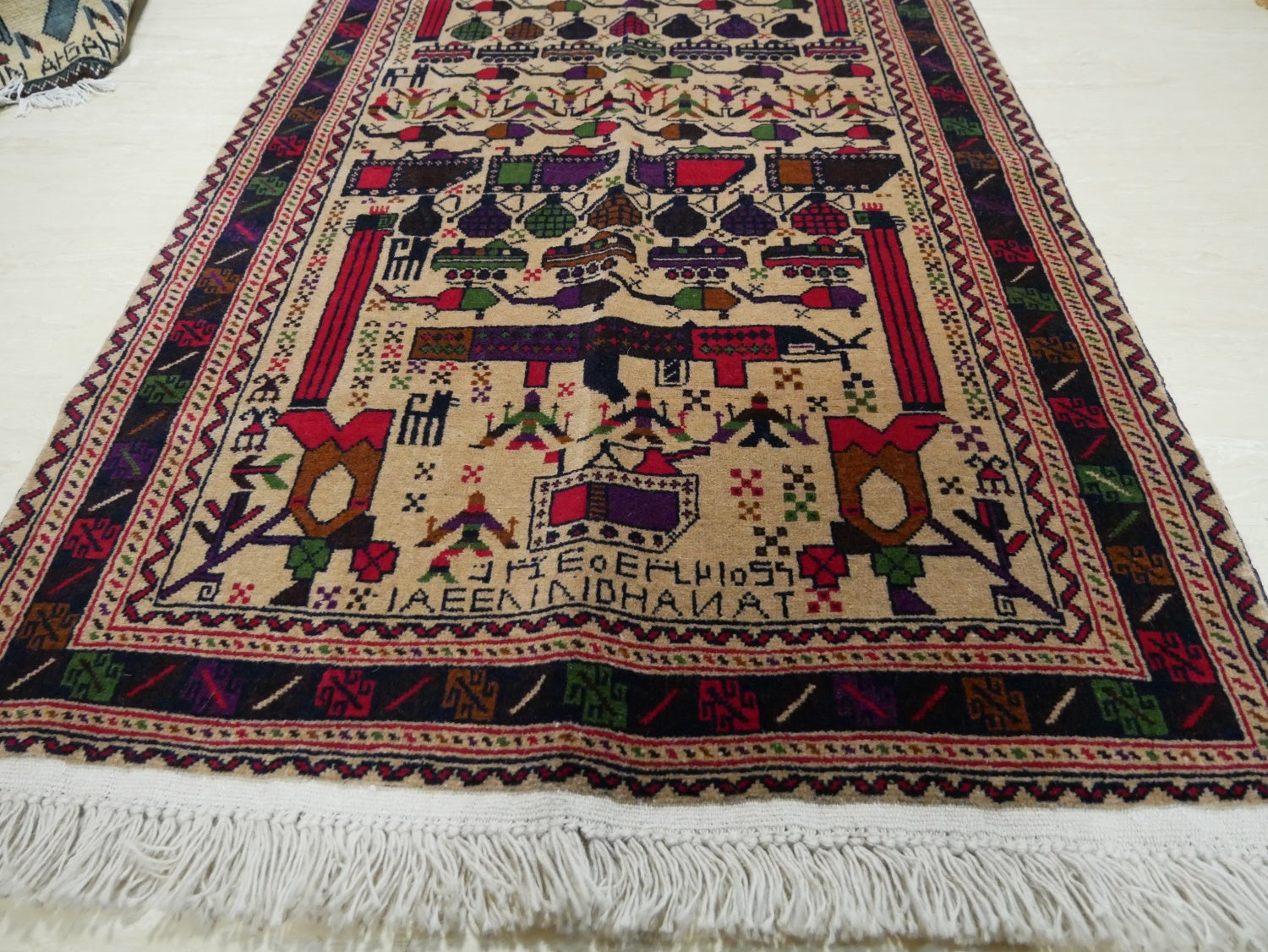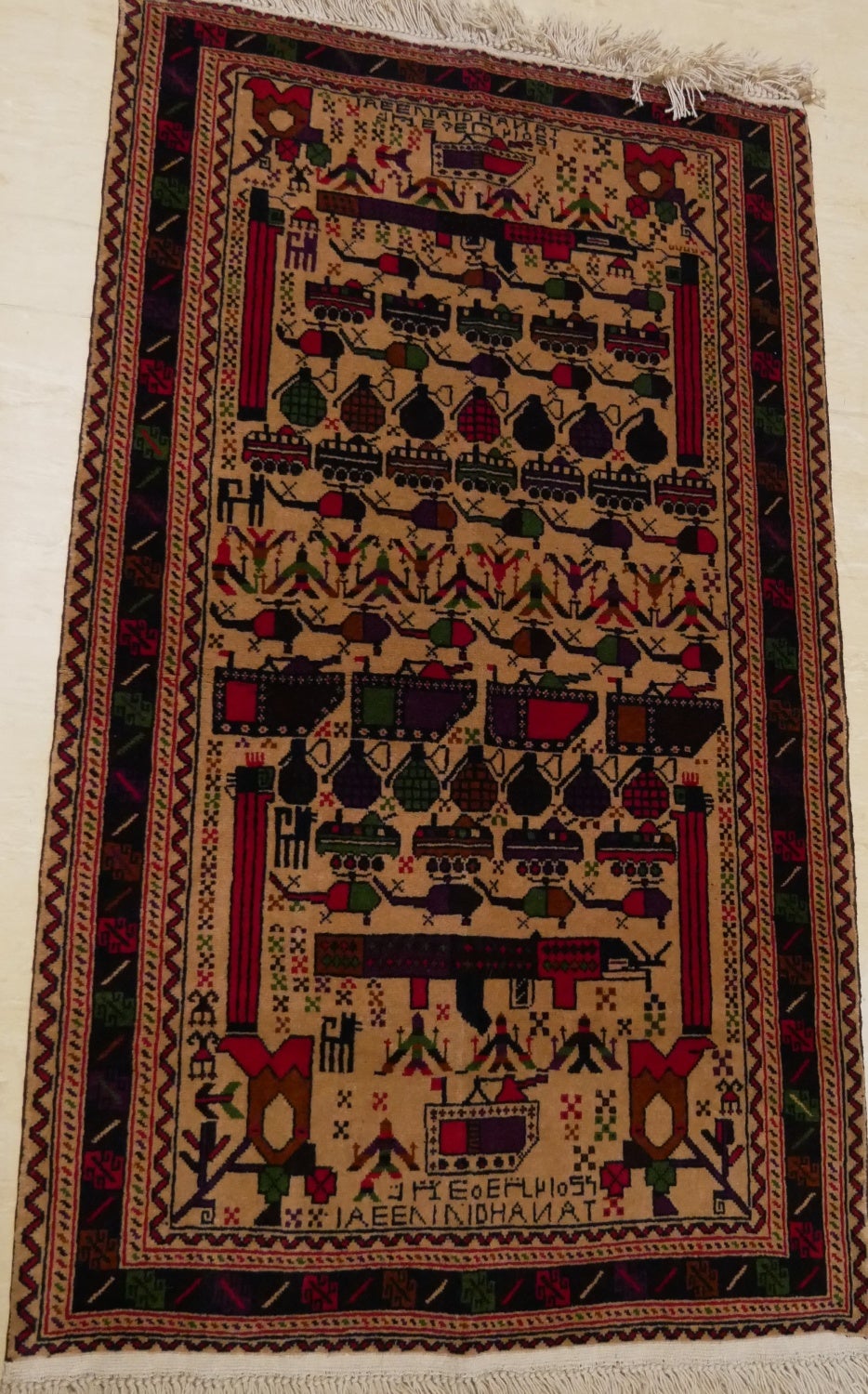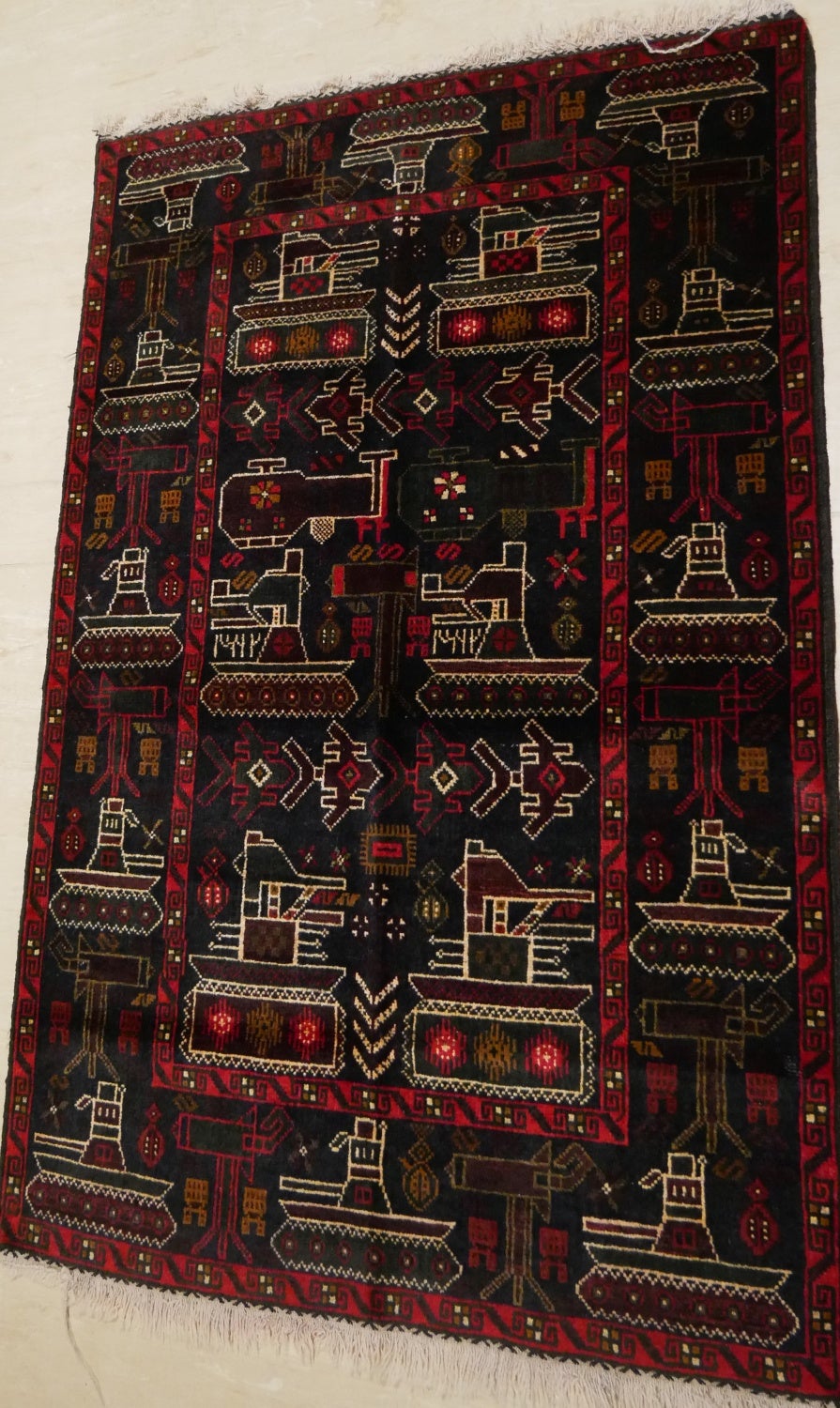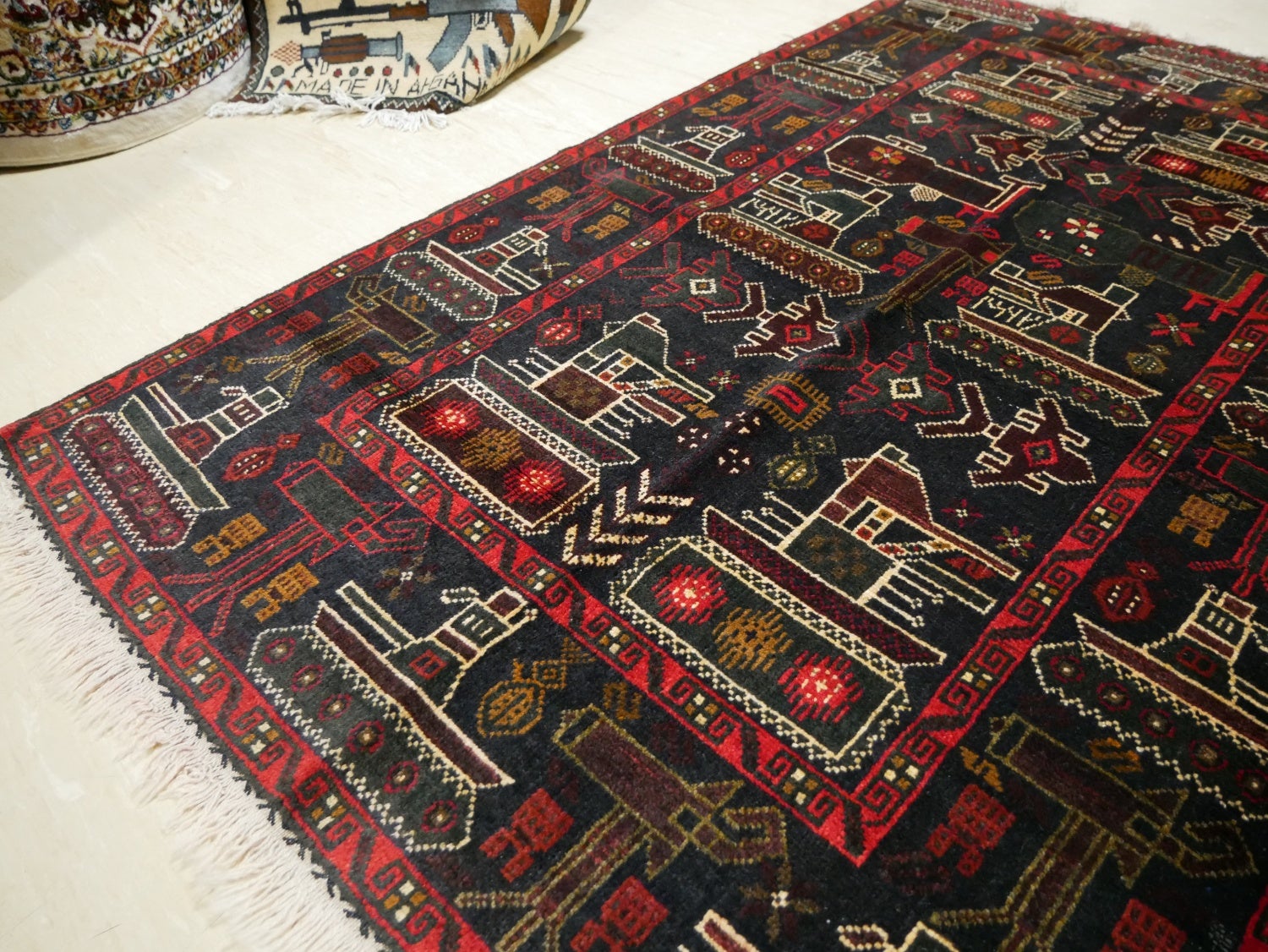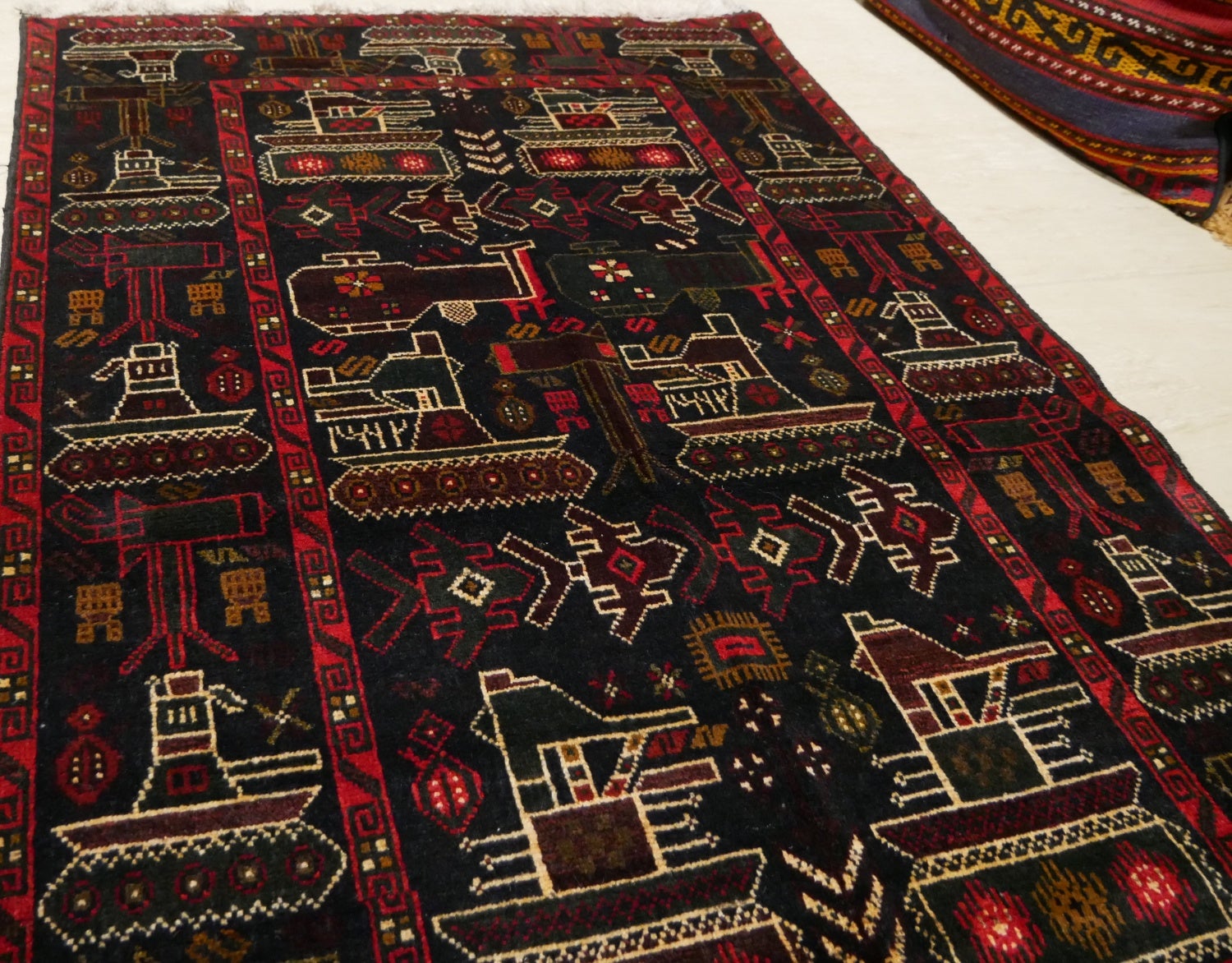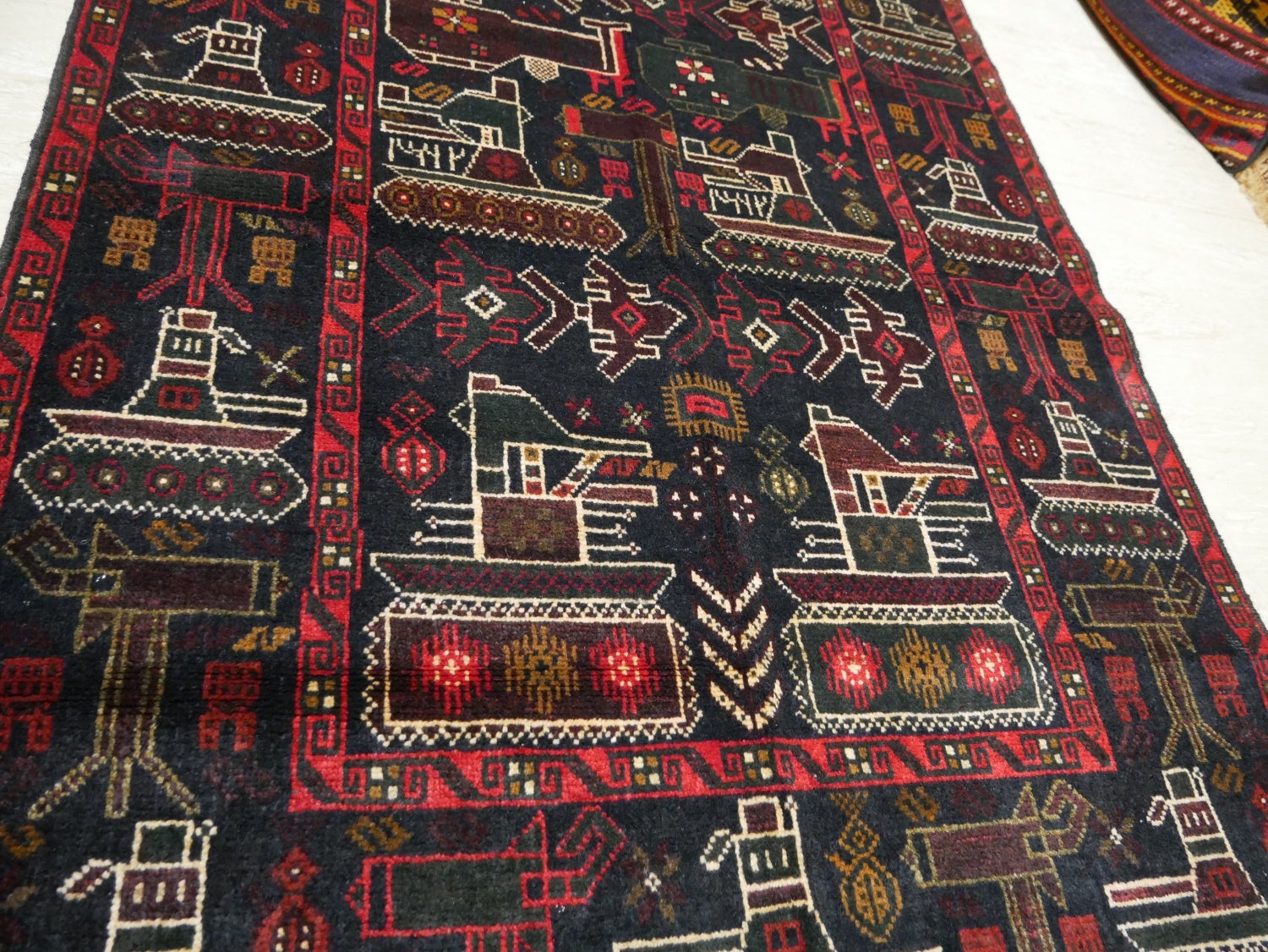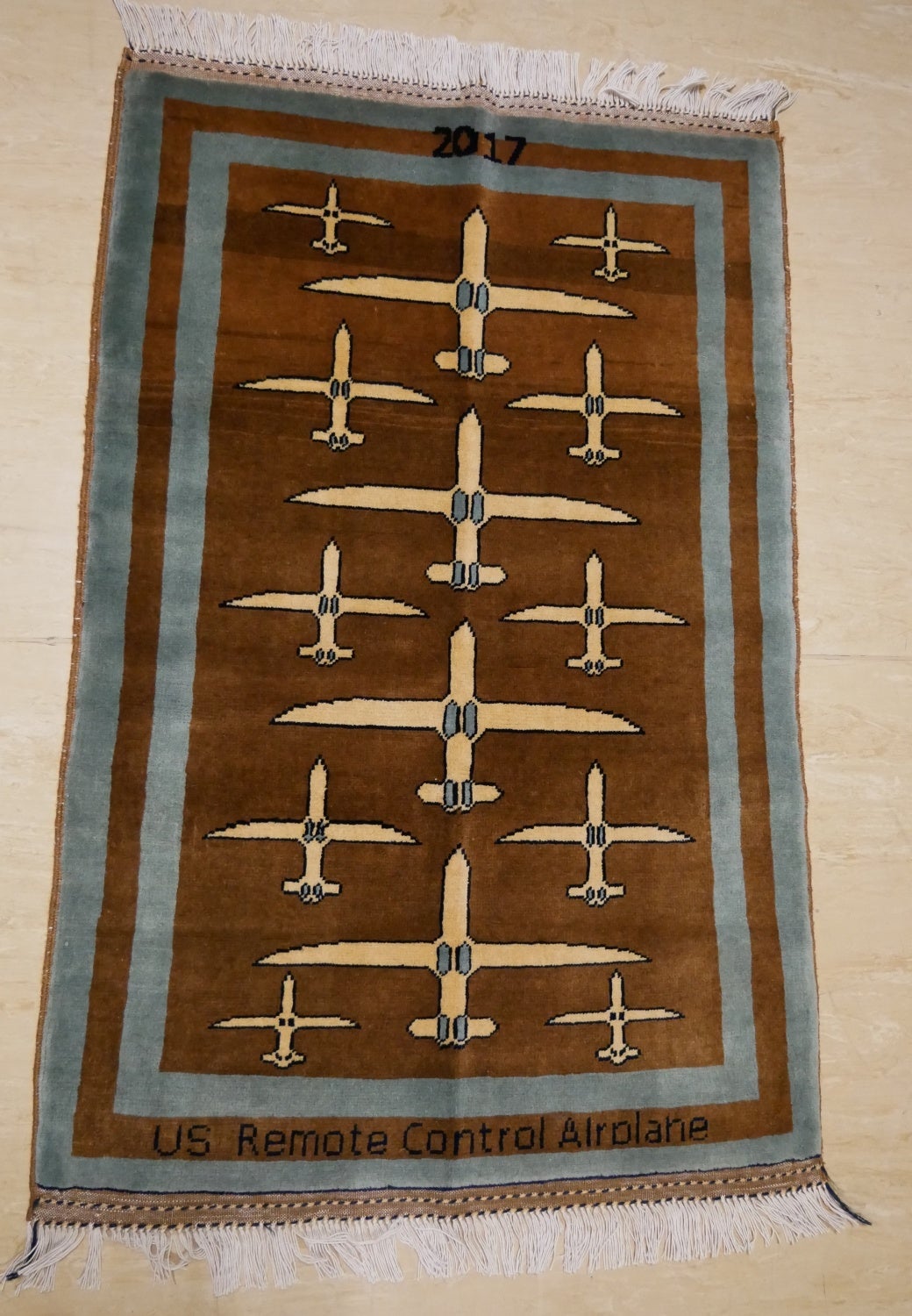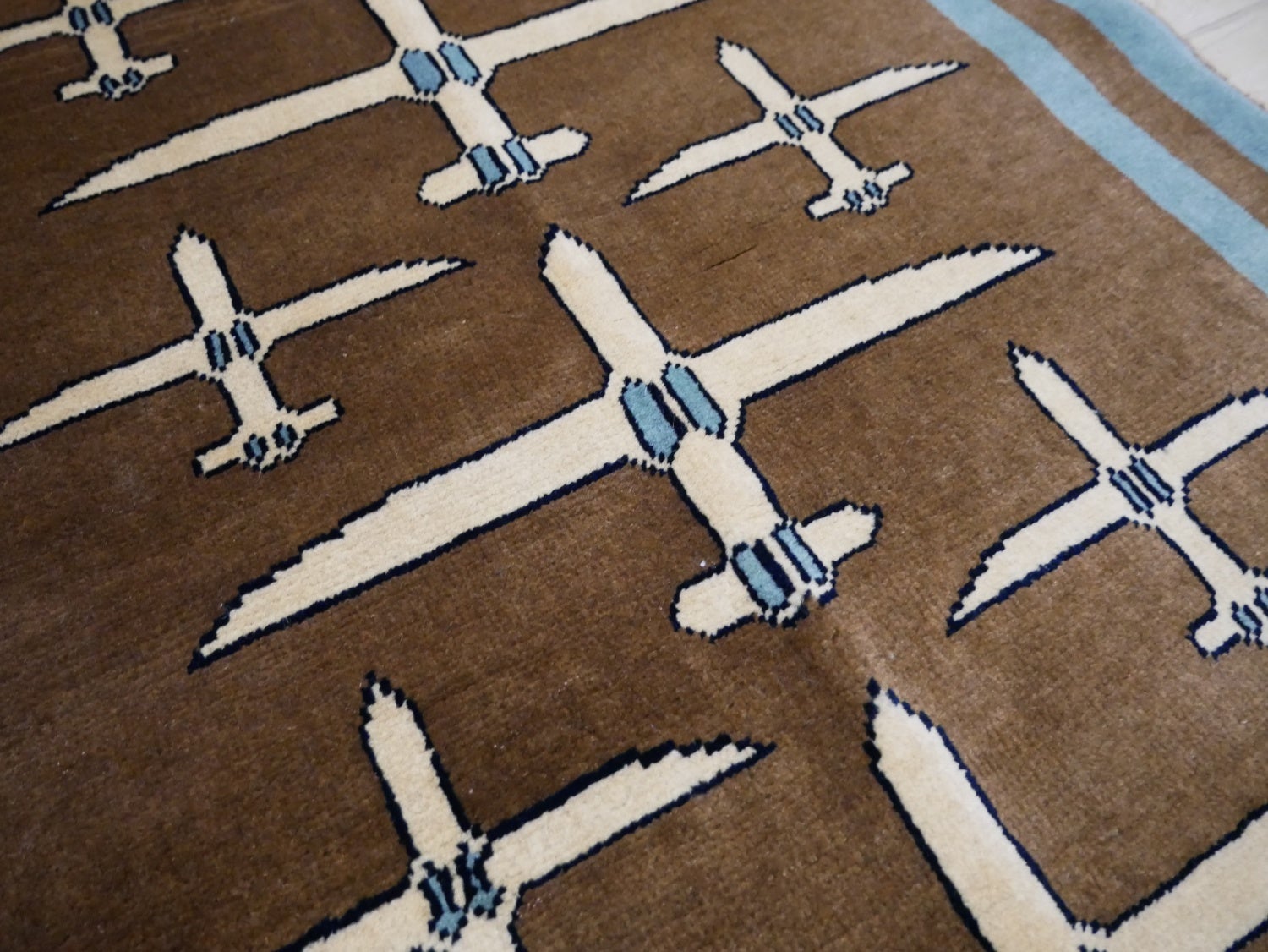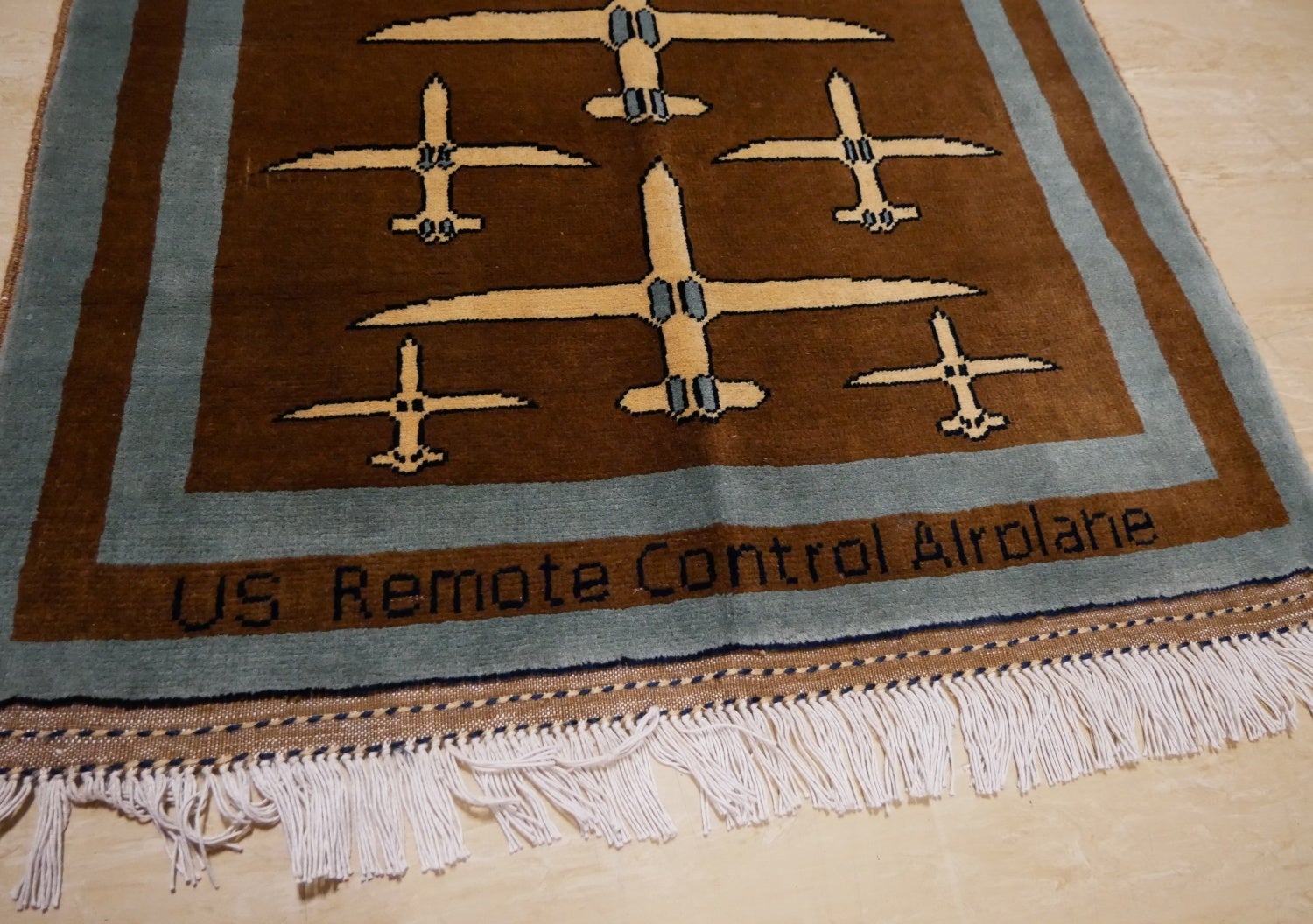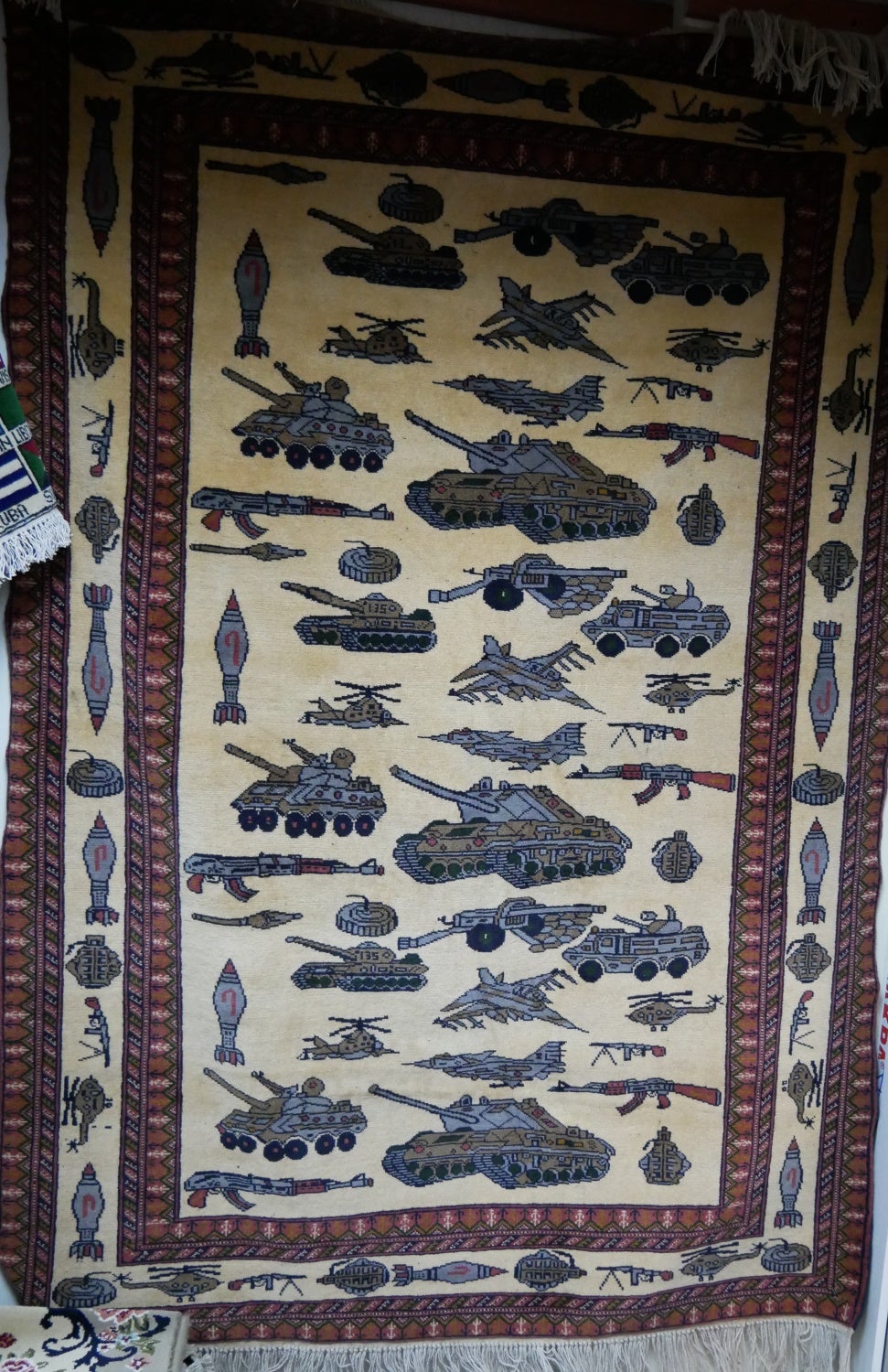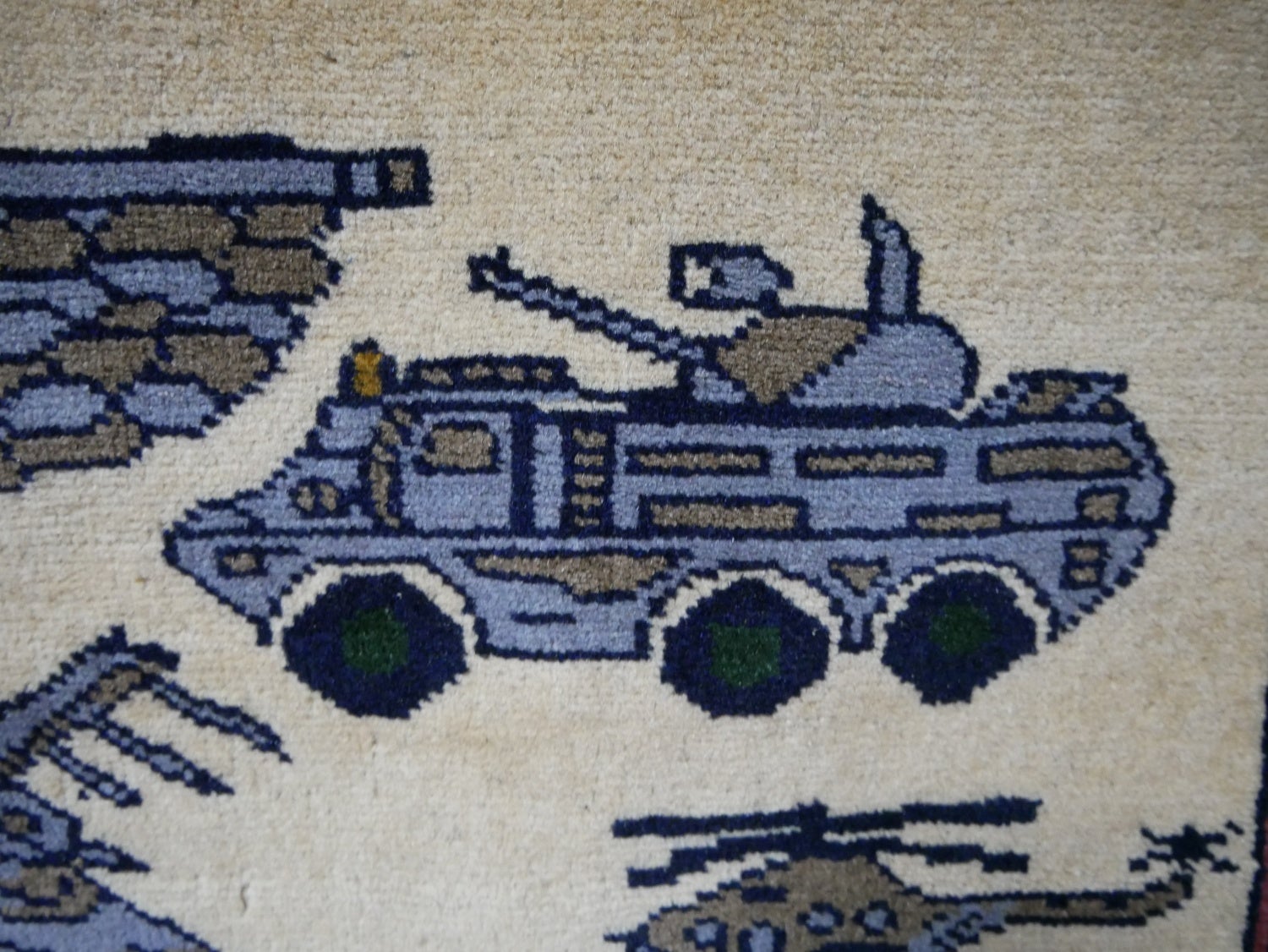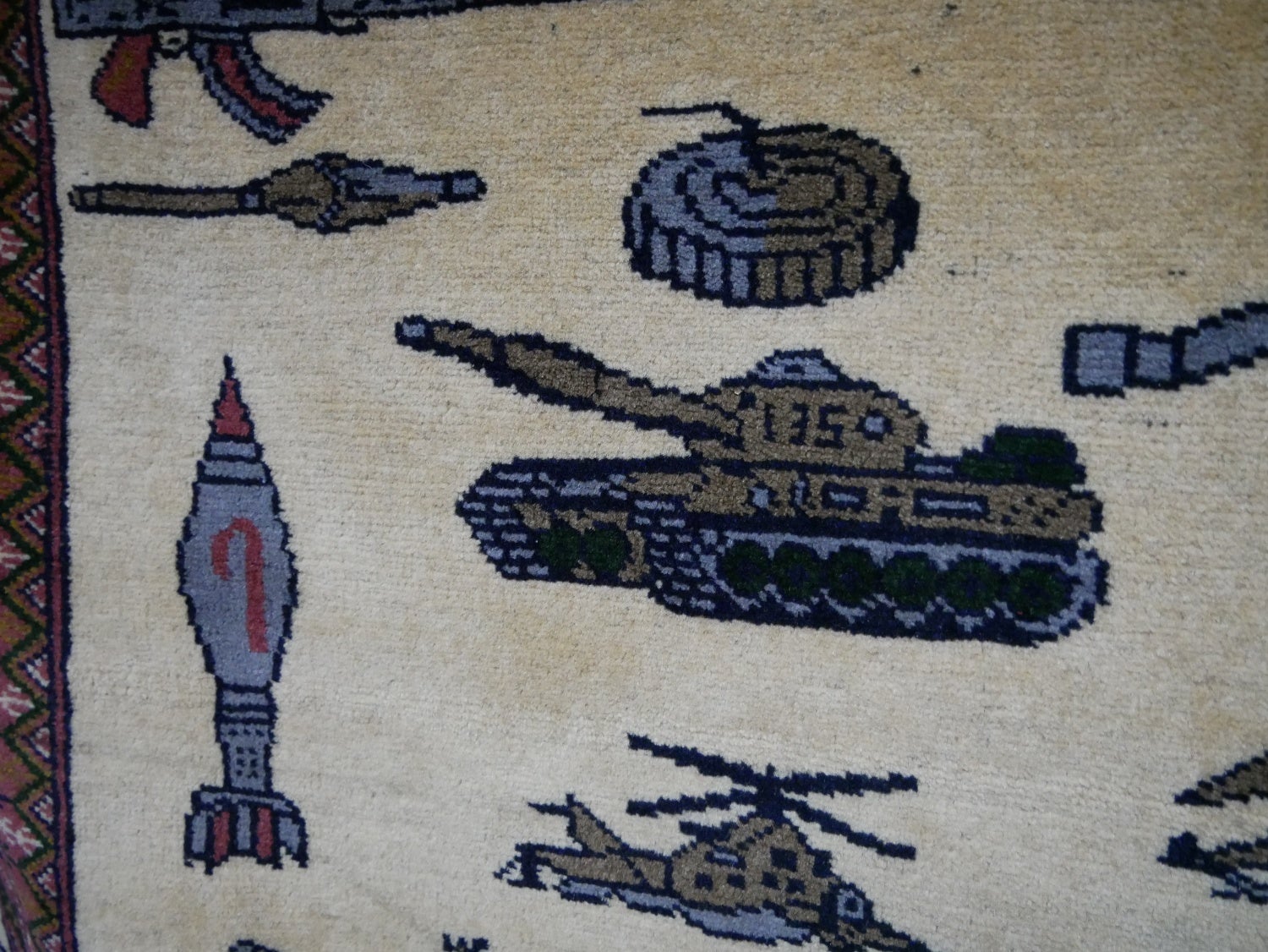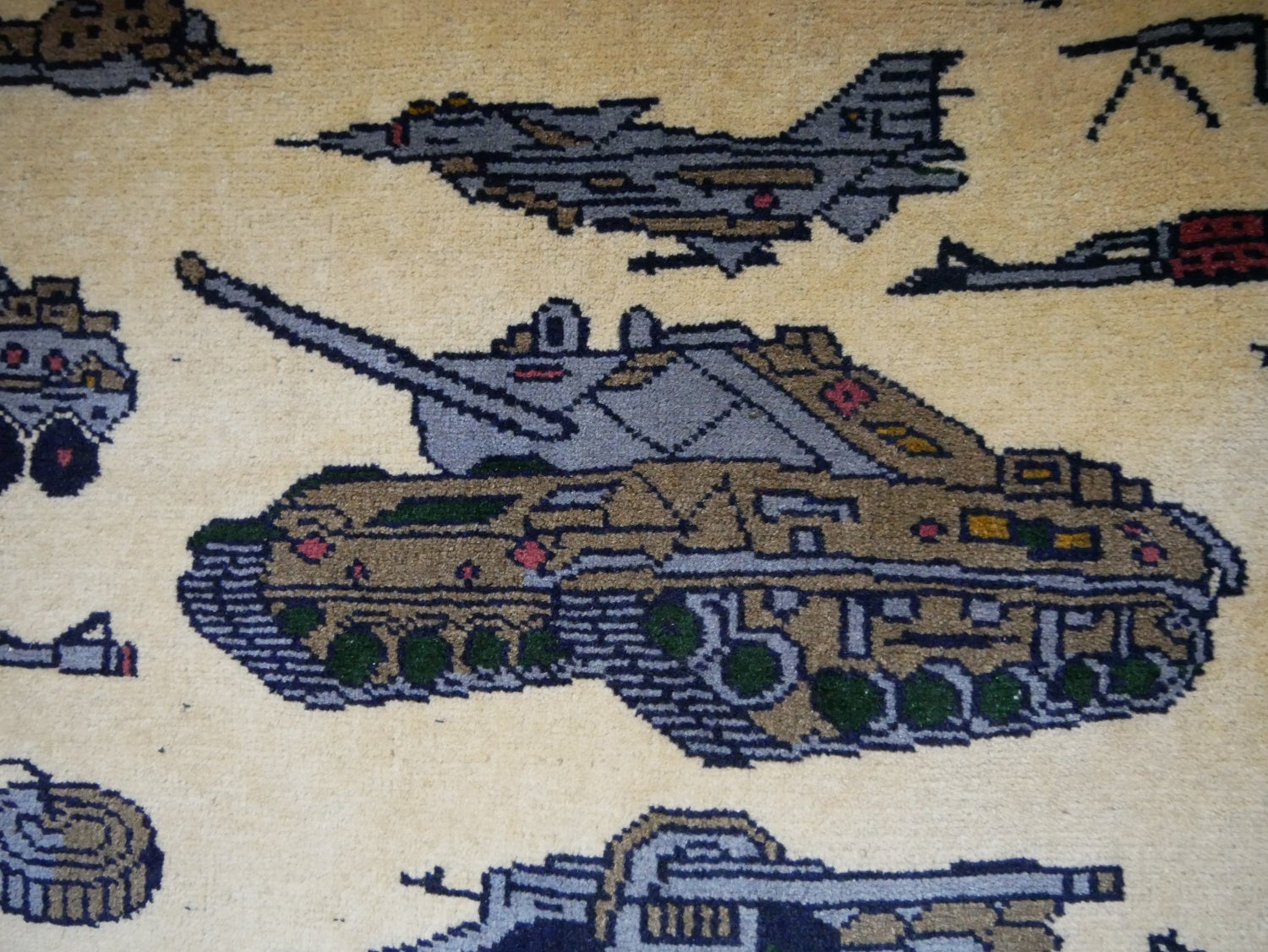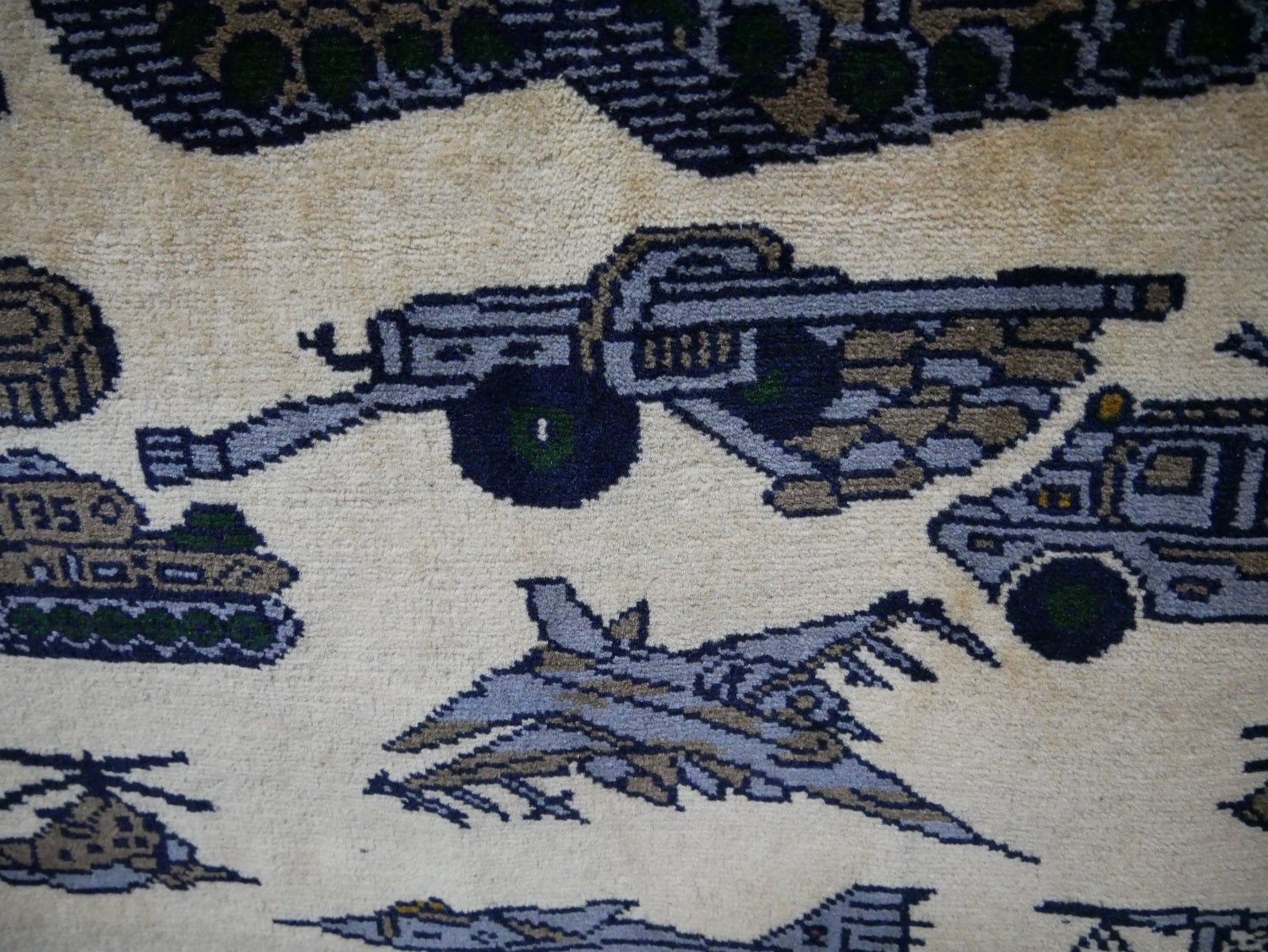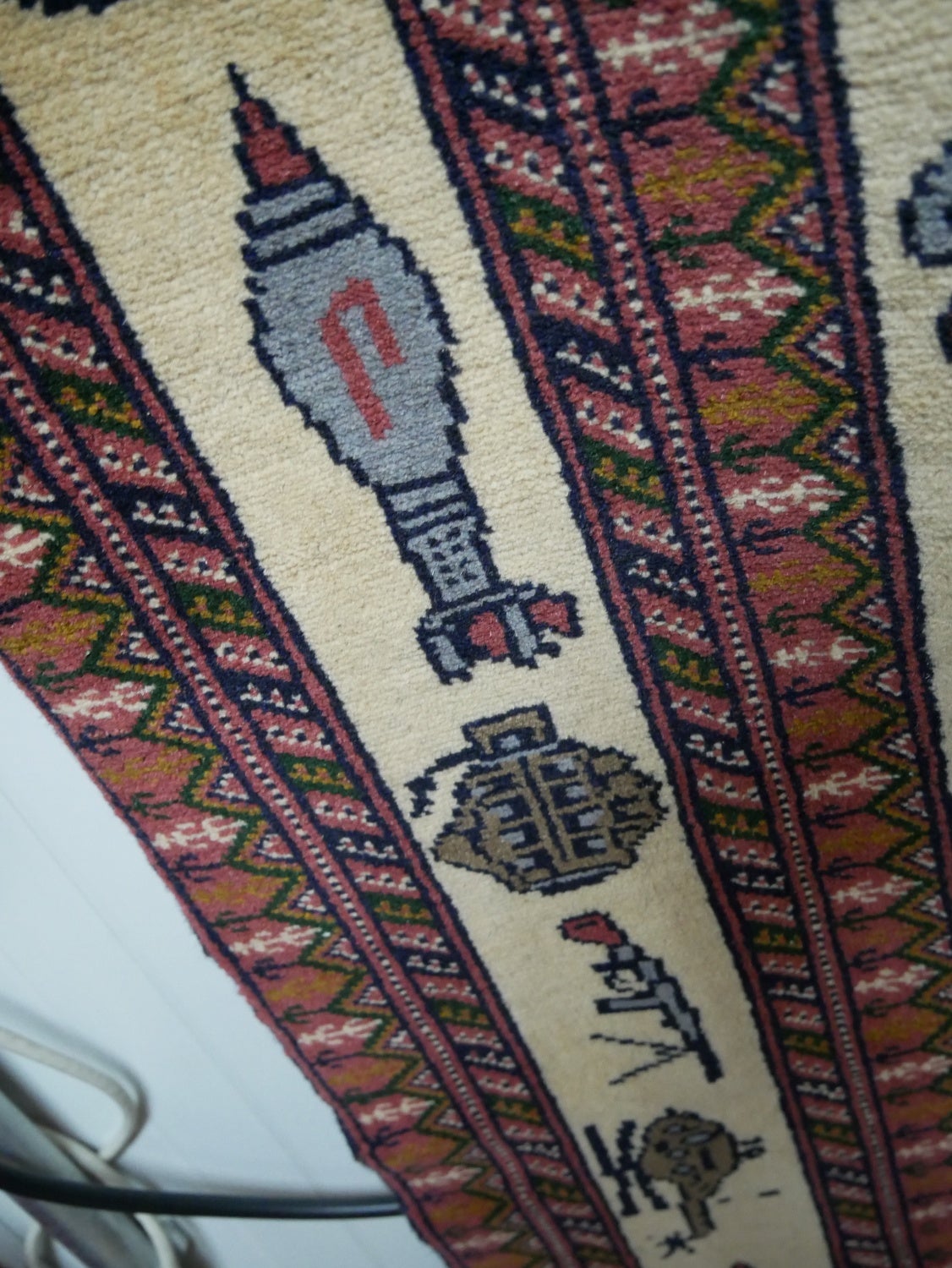Carpet sellers in Afghanistan call it a “Tup-e-Tung” in Dari, or what we know of in the United States as the “Afghan War Rug” in popular conception. This style of carpet initially became prevalent among tribal Baluchi women who weaved low profile designs into their carpets to signify the Soviet invasion and occupation thereafter beginning in December of 1979. The designs became more overt and wide spread after numerous years and started gaining interest among foreign buyers for their unique character displaying the Soviet occupation. The carpets themselves are a break from traditional Afghan carpet weaving. Afghan carpets are mostly based on certain designs or themes that are named after their designs or locales that they originated from. These don’t depict scenes or objects like the Tup-e-Tung carpets do, but instead intricate designs. In fact, Tup-e-Tungs are unique in that they are the only type of Afghan (or Persian/Iranian for that matter) carpet that portrays specific objects or people on the scale that they do.
Of course, the greatest irony of the Tup-e-Tung is completely lost among its Western customers and that is that Afghans in general don’t find them tasteful or are even interested in the carpets. The overwhelming majority of the sales are strictly intended for export outside of Afghanistan, or for foreigners inside the country. Talking to multiple carpet sellers in Kabul, I could clearly see the distaste that the subject of the Tup-e-Tungs brought to them, that of the current and previous conflicts that country has suffered through. From the Soviet invasion, the resulting civil war and mass chaos after Najibullah’s regime fell, the extremely oppressive Taliban rule, America’s invasion with Operation Enduring Freedom and the current Resolute Support mission, there is scarcely a single Afghan family that hasn’t been touched by the previous several decades of warfare. Especially in Kabul for people that remember the days in the early nineties when the city was literally ripped apart by infighting between Gulbuddin Hekmatyar and Massoud. So to us in the West they will continue to be a source of amusement, interest, curiosity. But at the end of the day, we have to realize that these carpets really serve just that, a novelty item, and shouldn’t be taken as some sort of deep introspective view of warfare in Afghanistan.
This article will go over some of the Tup-e-Tungs displayed at a carpet shop in Kabul. Although the carpets aren’t representative of the complete genre, they are indicative of a majority of the style in which they are weaved.
The initial carpet is one of the somewhat “stereotypical” designs, mainly showing a map of Afghanistan with the Soviets exiting the country in 1989 back over the Amu Darya River into Uzbekistan (then a Soviet Socialist Republic). The surrounding objects such as the AKM, RPG, Soviet grenades, BMPs, and Hind helicopters signify the various instruments of war involved with that occupation. The year designates the current year in which the carpet itself was weaved. Note with the depiction of the RPGs we constantly see them deployed with bipods. The anti-tank weapon did have bipods on some models, although the majority of RPG use throughout the world is without them. Sometimes these carpets get some very interesting and accurate detail, other times not so much.
This carpet signifies the U.S. invasion. Notice how the tanks have much more detail and appear to be more advanced than the BMPs in the earlier carpet. The mountains are filled with Black Hawk helicopters and four engine B52 bombers signifying the expensive operations in Tora Bora and follow on missions all over the eastern parts of the country. In the lowlands and plains are the tanks, where they can operate better. Surrounding the entire piece are RPG rockets, grenades, and landmines, showing either the left over ordnance from the Soviet years, or the current weapons of choice by the Taliban today.
This carpet is a blurring of time lines, showing a combination of a BMPs and AKMs, while also showing what appears to be a Vickers machine gun as a hold over from the third Anglo-Afghan War in 1919.
Instead of blurring, this carpet is intended to show the British involvement in the third Anglo-Afghan War with the older models of tanks and what looks to be a sort of Gatling gun design on the sides, complete with a tripod and manually operated crank mechanism. Or it could be a rocket with a fuse and wings. Within the middle tanks there appears to be the Dari numerals of ۱۳۶۲ or the year 1362. In the Islamic Hijri calendar this amounts to 1943, or in the Persian/Afghan one, 1983. It would appear to be the Hijri version due to the planes with engines on their wings, but that wouldn’t explain the apparent Gatling Gun.
This Predator drone inspired carpet apparently comes from a leaflet dropped by ISAF forces featuring a similar design of Predators, possibly to deter Taliban actions.
The final carpet is possibly the most detailed, showing in extreme intricacy the finer points of the various weapons and equipment displayed. From the field gun, the T72s, grenades, AKMs and the rockets to the BMPs and helicopters, there is an excellent attention to detail of all the tools displayed. Even some of the tanks have English numerals on the side denoting their units, not to mention the individual treads.
For more in-depth sources on these carpets check out these articles below-
Art News: From Combat to Carpet—The Strange Story of Afghan War Rugs
NPR: ‘War Rugs’ Reflect Afghanistan’s Long History With Conflict
Messynessychic: War Rugs: The Obscure Collectors Market for Afghan “Kitsch”
Buy one of your own at warrug.com
Much thanks to carpet seller Abdul and his shop in the U.S. Embassy in Kabul for allowing me to take photographs of his wares.
 Your Privacy Choices
Your Privacy Choices
